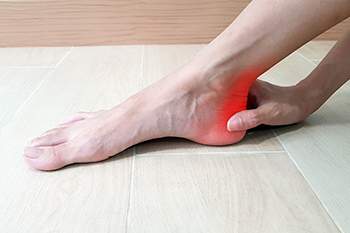
Heel pain and Achilles tendonitis are common foot issues caused by inflammation of the Achilles tendon, the band connecting the calf muscles to the heel bone. This pain often results from overuse, repetitive stress, or sudden increases in physical activity. Tight calf muscles, improper footwear, and poor foot mechanics, like flat feet or high arches, can also contribute. Athletes, especially runners, and middle-aged individuals engaging in sports are most at risk. However, anyone can develop Achilles tendonitis, particularly those who lead an active lifestyle or stand for extended periods. Ignoring the pain may worsen the condition, leading to chronic discomfort or even tendon tears. Rest and stretching can help, but persistent pain requires professional attention. If you are experiencing ongoing pain from Achilles tendonitis, it is strongly suggested that you schedule an appointment with a podiatrist for targeted treatment.
Achilles tendon injuries need immediate attention to avoid future complications. If you have any concerns, contact one of our podiatrists of Podiatry Inc.. Our doctors can provide the care you need to keep you pain-free and on your feet.
What Is the Achilles Tendon?
The Achilles tendon is a tendon that connects the lower leg muscles and calf to the heel of the foot. It is the strongest tendon in the human body and is essential for making movement possible. Because this tendon is such an integral part of the body, any injuries to it can create immense difficulties and should immediately be presented to a doctor.
What Are the Symptoms of an Achilles Tendon Injury?
There are various types of injuries that can affect the Achilles tendon. The two most common injuries are Achilles tendinitis and ruptures of the tendon.
Achilles Tendinitis Symptoms
- Inflammation
- Dull to severe pain
- Increased blood flow to the tendon
- Thickening of the tendon
Rupture Symptoms
- Extreme pain and swelling in the foot
- Total immobility
Treatment and Prevention
Achilles tendon injuries are diagnosed by a thorough physical evaluation, which can include an MRI. Treatment involves rest, physical therapy, and in some cases, surgery. However, various preventative measures can be taken to avoid these injuries, such as:
- Thorough stretching of the tendon before and after exercise
- Strengthening exercises like calf raises, squats, leg curls, leg extensions, leg raises, lunges, and leg presses
If you have any questions please feel free to contact our offices located in Beachwood, Mayfield Heights, Mentor, and Tallmadge, OH . We offer the newest diagnostic tools and technology to treat your foot and ankle needs.
